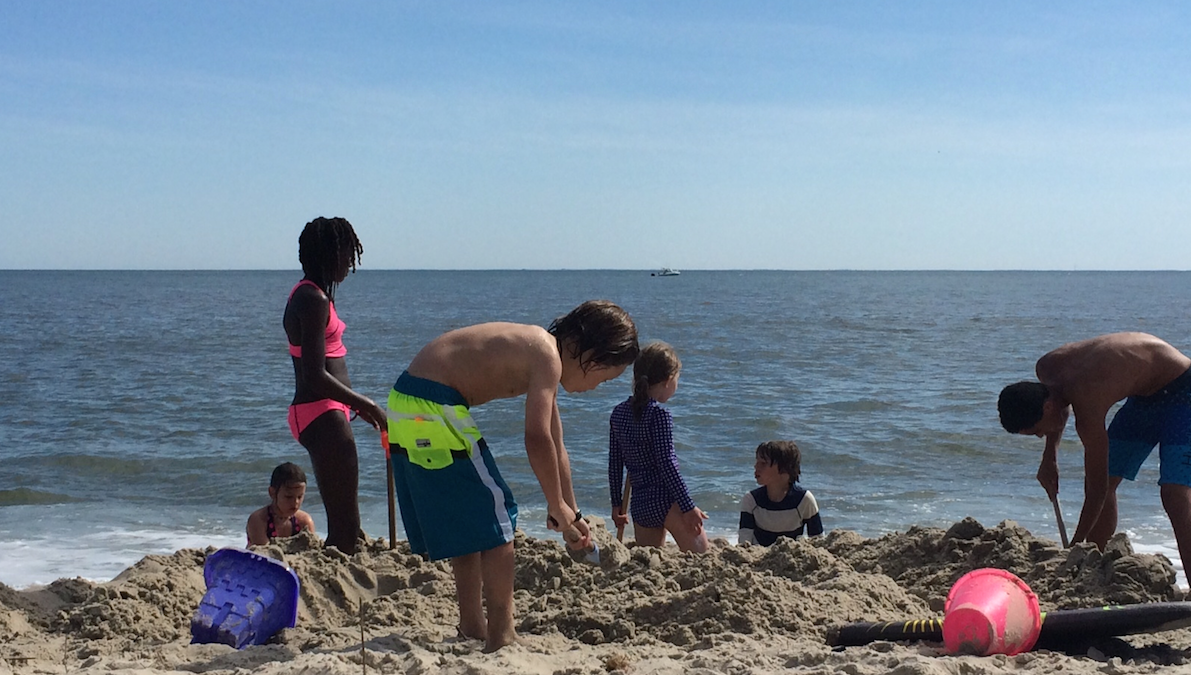8 ways to keep kids safe down the shore this summer
Listen
A good rule of thumb is not to dig holes deeper than waist-height of the shortest person in your group. (Jen Bradley/for NewsWorks)
Here’s a list of ways to keep kids safe and happy on the beach.
1. Only allow kids to swim near a lifeguard.
There are plenty of guarded beaches to be found along the shore, so stick to those for swimming. Always make sure kids swim with a buddy and in front of a lifeguard.
2. Watch the lifeguard flags.
These colorful flags aren’t just decorations or fancy adaptations of mood rings. The lifeguards on many Jersey beaches raise colored flags to let beachgoers know about the ocean conditions. Here’s how the breakdown works on most of the beaches we frequent:
Red flag with swimmer crossed out (or double red flag): No swimming allowed (too dangerous)
Red flag: High alert/strong currents/high surf
Yellow flag: Moderate conditions
Green flag: Calm conditions
Purple flag: Dangerous marine life
So think of the flag system as a traffic light with some purple thrown in for sea creatures.
3. Bring magic jellyfish spray.
Speaking of sea creatures, some days on the beach are better than others. When that purple flag goes up along the shore, it often means jellyfish are in the area. Lifeguards on our beach will often try to soothe stung humans with a simple concoction of water and vinegar. Even though the stinging sensation typically goes away after 10 to 15 minutes, having the spray on hand makes a huge difference, especially for kids.
4. Know how to spot and get out of a rip current.
Rip currents are powerful currents that run perpendicular to the shore and drag swimmers away from the beach. They can sometimes be spotted by looking at the surf and noticing a break in the wave pattern that looks like a path from the shore out to sea. If you find yourself caught in one, the way to escape it is to swim parallel to the shore, remain as calm as possible and call for help. We spend most of every summer on the beach, but my teenage son and I still found ourselves stuck in a rip current last summer. Even with the knowledge I thought I had about them, it was difficult to stay calm and get us both safely back to shore. Click here for more information on rip currents.
5. Keep on top of local news.
News can be a great source for unusual marine life sightings (like the great white shark seen off of Cape May earlier this summer) or a flurry of dangerous rip currents in certain areas. Since the ocean is different every day, it’s important to stay informed.
6. Watch for mouthfuls of water.
If your child struggles in the ocean or pool and swallows a significant amount of water or experiences a near drowning, seek medical attention even if he or she seems fine afterwards. Children are at risk for secondary drowning, a fatal event that can occur up to 24 hours after struggling in the water. Click here for more information on secondary drowning.
7. Don’t dig deep!
Sand holes can suddenly cave in, literally burying a person alive. Even when there are witnesses to such an event, it can take rescuers too long to dig out a trapped victim. Allowing bigger kids to dig elaborate tunnels or large holes for small kids to play in puts them at risk. A good rule of thumb is not to dig holes deeper than waist-height of the shortest person in your group. And always fill in holes when you leave the beach so that others aren’t injured falling into them. It’s part of beach etiquette.
8. Slather them in sunblock.
The way kids play at the beach is very different than the way they play elsewhere, so be sure to really beef up the SPF and their coverage. Look for those tricky spots like bathing suit lines, back and shoulders, ears, and just under their eyes. Make sure to reapply every two hours. You can set a cellphone alarm to remind yourself.
There is a world of fun to be had “down the shore,” and these simple precautions can help ensure that everyone goes home safe and happy.
WHYY is your source for fact-based, in-depth journalism and information. As a nonprofit organization, we rely on financial support from readers like you. Please give today.

